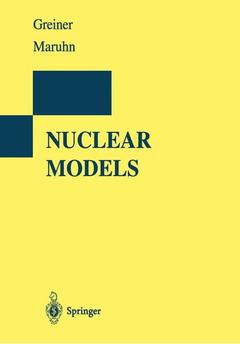Nuclear Models, 1996
Langue : Anglais
Auteurs : Greiner Walter, Maruhn Joachim A.
Préfacier : Bromley D.A.

Theoretical physics has become a many-faceted science. For the young student it is difficult enough to cope with the overwhelming amount of new scientific material that has to be learned, let alone to obtain an overview of the entire field, which ranges from mechanics through electrodynamics, quantum mechanics, field theory, nuclear and heavy-ion science, statistical mechanics, thermodynamics, and solid state theory to elementary-particle physics. And this knowledge should be acquired in just 8-10 semesters during which, in addition, a Diploma or Master's thesis has to be worked on or examinations prepared for. All this can be achieved only if the university teachers help to introduce the student to the new disciplines as early on as possible, in order to create interest and excitement that in turn set free essential new energy. Naturally, all inessential material must simply be eliminated. At the Johann Wolfgang Goethe University in Frankfurt we therefore confront the student with theoretical physics immediately in the first semester. Theoretical Mechanics I and II, Electrodynamics, and Quantum Mechanics I - an Introduction are the basic courses during the first two years. These lectures are supplemented with many mathematical explanations and much support material. After the fourth semester of studies, graduate work begins and Quantum Mechanics II - Symme tries, Statistical Mechanics and Thermodynamics, Relativistic Quantum Mechanics, Quantum Electrodynamics, the Gauge Theory of Weak Interactions, and Quantum Chromodynamics are obligatory.
1. Introduction.- 1.1 Nuclear Structure Physics.- 1.2 The Basic Equation.- 1.3 Microscopic versus Collective Models.- 1.4 The Role of Symmetries.- 2. Symmetries.- 2.1 General Remarks.- 2.2 Translation.- 2.3 Rotation.- 2.4 Isospin.- 2.5 Parity.- 2.6 Time Reversal.- 3. Second Quantization.- 3.1 General Formalism.- 3.2 Representation of Operators.- 3.3 Evaluation of Matrix Element for Fermions.- 3.4 The Particle-Hole Picture.- 4. Group Theory in Nuclear Physics.- 4.1 Lie Groups and Lie Algebras.- 4.2 Group Chains.- 4.3 Lie Algebras in Second Quantization.- 5. Electromagnetic Moments and Transitions.- 5.1 Introduction.- 5.2 The Quantized Electromagnetic Field.- 5.3 Radiation Fields of Good Angular Momentum.- 5.4 Coupling of Radiation and Matter.- 6. Collective Models.- 6.1 Nuclear Matter.- 6.2 Nuclear Surface Deformations.- 6.3 Surface Vibrations.- 6.4 Rotating Nuclei.- 6.5 The Rotation-Vibration Model.- 6.6 ?-Unstable Nuclei.- 6.7 More General Collective Models for Surface Vibrations.- 6.8 The Interacting Boson Model.- 6.9 Giant Resonances.- 7. Microscopic Models.- 7.1 The Nucleon-Nucleon Interaction.- 7.2 The Hartree—Fock Approximation.- 7.3 Phenomenological Single-Particle Models.- 7.4 The Relativistic Mean-Field Model.- 7.5 Pairing.- 8. Interplay of Collective and Single-Particle Motion.- 8.1 The Core-plus-Particle Models.- 8.2 Collective Vibrations in Microscopic Models.- 9. Large-Amplitude Collective Motion.- 9.1 Introduction.- 9.2 The Macroscopic-Microscopic Method.- 9.3 Mass Parameters and the Cranking Model.- 9.4 Time-Dependent Hartree—Fock.- 9.5 The Generator-Coordinate Method.- 9.6 High-Spin States.- Appendix: Some Formulas from Angular-Momentum Theory.- References.
Date de parution : 05-1997
Thème de Nuclear Models :
© 2024 LAVOISIER S.A.S.
